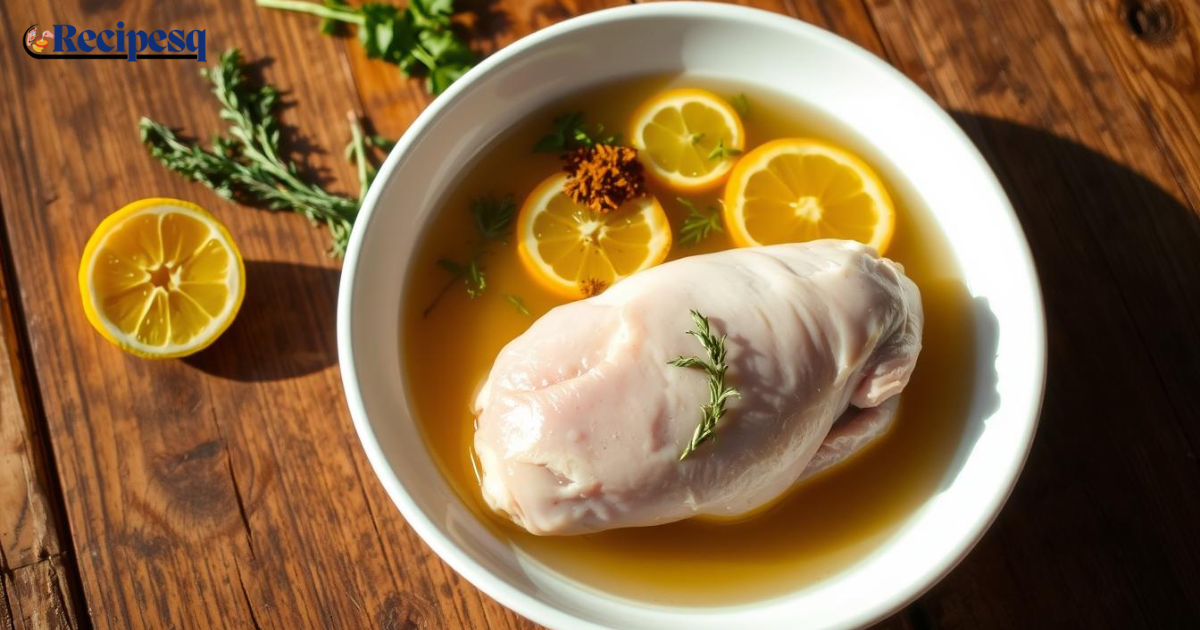How to Brine Chicken for Tender, Flavorful Results

When cooking chicken, you want it to be tender and full of flavor. Learning how to brine chicken is a great way to do this. A brining guide can help you understand the process and its benefits. Brining chicken is a simple yet powerful technique that can make your cooking better.
By following a few basic steps, you can make delicious and moist chicken dishes. These dishes will impress your family and friends.

To start brining, you need to know the basics. A good chicken brining guide will show you how to prepare the brine and cook the chicken. You’ll learn how to brine chicken to get the perfect balance of flavors and textures.
With this knowledge, you can try different seasonings and ingredients. This way, you can create unique and delicious dishes.
Key Takeaways
- Learning how to brine chicken can improve the tenderness and flavor of your dishes
- A chicken brining guide can provide you with the necessary steps and techniques
- Brining chicken is a simple and effective way to elevate your cooking
- Understanding the basics of brining can help you create delicious and moist chicken dishes
- Experimenting with different seasonings and ingredients can help you create unique flavors
- Following a chicken brining guide can help you achieve consistent and impressive results
Understanding the Science Behind Chicken Brining
Brining chicken makes it tender and flavorful. It involves soaking the chicken in a salty solution. This helps tenderize the meat and add taste.
The brining process works through osmosis. Salt and other seasonings in the brine break down meat proteins. This makes the chicken tender and juicy. Brining also makes the chicken safe to eat and cooks faster.
When brining chicken, consider the salt-to-water ratio and brine temperature. The soaking time is also important. By trying different brining methods, you can find what works best for you. Whether you’re a pro or a beginner, knowing the science of brining can elevate your cooking.
There are several brining methods, like wet, dry, and combination brining. Each has its own benefits and drawbacks. The right method depends on your taste and the chicken type. Exploring these options can help you achieve delicious, tender chicken that wows everyone.
Benefits of Brining Your Chicken
Brining chicken is a great way to make it tender and flavorful. It improves the chicken’s texture, making it juicy and tender. This is key for leaner cuts that can get dry and tough.
Brining also boosts the chicken’s flavor. It adds depth and complexity, making the meat more enjoyable. Plus, it helps keep the chicken moist, even when cooked dry methods like grilling or roasting.
- Improved texture and tenderness
- Enhanced flavor and aroma
- Increased moisture retention
Adding brining to your chicken prep can elevate your cooking. It’s a technique that works for both seasoned chefs and beginners. Give it a try to see the difference it makes.
Essential Ingredients for a Basic Chicken Brine
To make a tasty chicken brine, focus on key ingredients. A brine mix usually has water, salt, and aromatics. Finding the right flavor balance is crucial for enhancing chicken taste.
For the salt-to-water ratio, use 1 cup of kosher salt per 1 gallon of water. This makes a basic brine you can tweak. Adding garlic, onion, and herbs can make your chicken taste even better.
Salt-to-Water Ratio Guidelines
The salt you choose matters a lot. Use kosher salt or sea salt for cooking. These salts improve flavor and texture in your brine.
Optional Aromatics and Seasonings
Here are some great additions to your chicken brine:
- Garlic: minced or crushed garlic adds a rich, savory flavor
- Onion: sliced or chopped onion adds a sweet, caramelized flavor
- Herbs: fresh or dried herbs like thyme, rosemary, or parsley add a fragrant, aromatic flavor
Choosing the Right Salt Type
By following these tips and using the right ingredients, you can make a tasty chicken brine. With practice and trying different brines, you’ll get tender, flavorful chicken every time.
How to Brine Chicken: Step-by-Step Guide
To get perfectly brined chicken, follow a simple guide. First, prepare your chicken and brine solution. Make sure the chicken is fully covered in the brine. This is key for even flavor.
When brining chicken, refrigeration is crucial. Keep the chicken in the fridge at a safe temperature. This step is important for food safety and helps you get perfectly brined chicken.
Here are some key points to consider when brining chicken:
- Use a large container to hold the chicken and brine solution.
- Keep the chicken refrigerated at a temperature of 40°F (4°C) or below.
- Allow the chicken to brine for the recommended time, usually several hours or overnight.
After brining, remove the chicken and pat it dry with paper towels. This helps the chicken cook evenly and prevents steaming. By following these steps, you’ll get delicious and tender chicken.

Always handle the chicken safely and cook it to the right temperature. With practice, you’ll become a pro at brining chicken and enjoy perfect results every time.
Different Brining Methods for Various Cuts
Brining chicken requires different methods for different cuts. The debate between brining and marinating chicken is common. But, the right brining method can make chicken tender and flavorful. It’s important to know that whole chickens, chicken breasts, and dark meat are all different.
Whole chickens need longer brining times to soak up flavors evenly. The best brining methods use a mix of salt, sugar, and spices. Chicken breasts and dark meat, however, can be brined for shorter times. The goal is to balance flavor and texture.
Brining and marinating chicken differ in moisture and texture. Brining keeps chicken moist, while marinating can dry it out. Choosing the right brining method for your chicken can make it tender and juicy. Popular brining methods include:
- Wet brining: This involves soaking the chicken in a brine solution. It’s time-consuming but gives great results.
- Dry brining: This method uses a dry spice blend rubbed on the chicken. It’s quicker and easier.
The choice of brining method depends on your preference and the chicken type. Experimenting with different techniques can elevate your chicken dishes. You’ll enjoy a more flavorful and tender final product.
Common Brining Mistakes to Avoid
When trying to tips for perfectly brined chicken, it’s key to steer clear of common errors. One big mistake is over-salting, which can make the chicken taste bad and feel tough. To dodge this, stick to the salt-to-water ratio that’s suggested.
Another common mistake is brining the chicken too little. This can make it taste bland and dry. To fix this, let the chicken brine for the right amount of time. Also, keep an eye on the temperature to make sure it’s safe.
Some other common mistakes to watch out for include:
- Not patting the chicken dry before cooking, which can prevent even browning
- Not using the right type of salt, which can affect the flavor and texture
- Not storing the chicken properly during the brining process, which can lead to contamination
By knowing these common mistakes and avoiding them, you can make sure your chicken is brined just right. Always follow tips for perfectly brined chicken and take the right steps for the best results.
Time and Temperature Guidelines
Brining chicken needs the right timing and temperature for the best taste and tenderness. It’s important to know the safe brining times and temperatures. Making your own brine is great, but following guidelines is key to avoid food safety issues.
Brining chicken for at least 30 minutes to several hours or overnight is a good rule. The goal is to find the perfect balance of brining time and temperature. For example, smaller chicken cuts might need less time, while bigger ones might need more.
Important safe brining practices include:
- Keeping the brine solution at a consistent refrigerator temperature (below 40°F) to prevent bacterial growth
- Using a food-safe container and utensils to handle the chicken and brine solution
- Labeling and dating the container to ensure you use the oldest brine solution first
By following these tips and using your homemade brine, you can enjoy tasty and tender chicken. Always remember to prioritize food safety and handle the chicken and brine carefully.
Dry Brining vs. Wet Brining
When it comes to brining poultry, you have two main options: dry brining and wet brining. Both methods have their own set of benefits and drawbacks. The right choice depends on your personal preferences and the dish you’re preparing. Dry brining, also known as pre-salting, involves rubbing the meat with salt and letting it sit before cooking. This method is great for enhancing the natural flavors of the meat and creating a crispy crust.
Wet brining, on the other hand, involves soaking the meat in a saltwater solution. This helps to lock in moisture and add flavor. It’s ideal for cooking methods like roasting or grilling, where you want a juicy and tender final product. Both methods improve the texture, flavor, and overall eating experience of poultry.

Here are some key points to consider when deciding between dry brining and wet brining:
- Dry brining is a more convenient and less messy option, as it doesn’t require a large container or a lot of liquid.
- Wet brining is better suited for larger cuts of meat, as it allows for more even distribution of flavor and moisture.
- Dry brining can result in a more intense flavor, as the salt and seasonings are able to penetrate deeper into the meat.
- Wet brining is a more forgiving method, as it allows for some flexibility in terms of cooking time and temperature.
Ultimately, the choice between dry brining and wet brining comes down to your personal preferences and the specific dish you’re preparing. By understanding the benefits and drawbacks of each method, you can make an informed decision. This will help you achieve the best possible results for your poultry dishes.
Flavor Variations and Creative Brine Recipes
Exploring how to brine chicken opens up a world of flavors. You can mix and match ingredients to make a easy chicken brine recipe that’s all your own. Try adding herbs like thyme or rosemary for a savory taste.
Here are some ideas for creative brine recipes:
- Use citrus fruits like lemons or oranges for a burst of citrus flavor
- Add spices like garlic or paprika for a smoky taste
- Try different salts, like sea salt or kosher salt, for a unique flavor
The secret to a great easy chicken brine recipe is to have fun and experiment. Don’t hesitate to try new flavors and adjust the ingredients to your taste. With a bit of practice, you’ll master how to brine chicken in no time.
Conclusion: Mastering the Art of Chicken Brining
Throughout this guide, you’ve learned how chicken brining can transform your cooking. It makes your chicken tender and full of flavor. By understanding the science and using the right techniques, you can make your chicken dishes stand out.
Brining does more than just make chicken moist. It lets you try different seasonings and aromatics. This way, you can create unique flavors for your chicken. You can go for a simple salt-and-pepper brine or try something more adventurous.
Keep practicing and experimenting with brining. Soon, you’ll be able to make chicken that’s always juicy and full of flavor. Your family and friends will love it.
So, start using brining to take your chicken dishes to the next level. Let your creativity shine and enjoy the delicious results.
FAQ
What is the purpose of brining chicken?
Brining chicken makes the meat tender and flavorful. It involves soaking the chicken in saltwater. This locks in moisture, making the chicken juicy and tender.
How long should I brine chicken?
Brining time varies. For 30 minutes to 12 hours is common. Whole chickens need longer, while breasts or thighs can be brined for less time.
What type of salt should I use for brining?
Use kosher salt, sea salt, or canning/pickling salt. These dissolve well and are effective. Table salt is not recommended due to additives.
Can I brine chicken that has been previously frozen?
Yes, you can brine frozen chicken. It’s especially helpful as it rehydrates the meat and adds moisture.
How do I know when the chicken is done brining?
The chicken is done when it feels firmer and the brine has fully penetrated. Use a meat thermometer for an internal temperature of 40°F to 45°F.
Can I reuse the brine solution?
No, it’s best not to reuse the brine. It can harbor bacteria from the chicken. Always make a fresh brine for each batch.
What are the benefits of dry brining compared to wet brining?
Dry brining is quicker and easier, making the skin crispier. Wet brining, however, makes the chicken juicier but takes more time and space.




